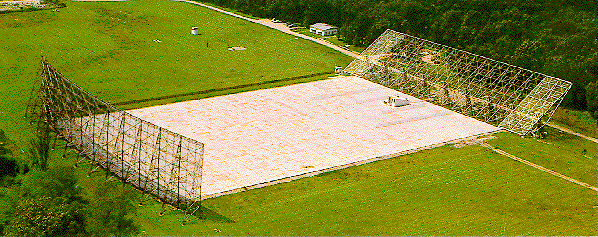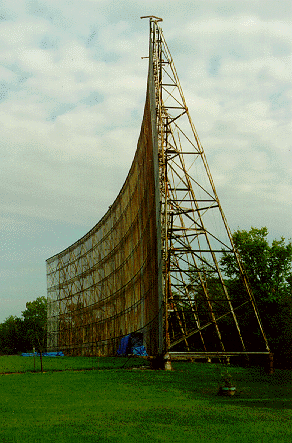Ohio State University Radio Observatory

The Big Ear telescope, showing the parabolic reflector to the left and the flat reflector to the right.

The parabolic reflector.
Ohio State University Radio Observatory was a facility originally sited near Delaware, Ohio, and centered around the Big Ear telescope used in the Ohio SETI Program. The OSU Radio Observatory has later relocated to the west campus of the University where it shared a site with the Electroscience Laboratory.
The Observatory's long-standing director was John D. Kraus (1910–2004). A pioneer of radio telescope design since the 1940s, Kraus obtained his BS in Physics (1931) and PhD (1933) from the University of Michigan and came to Ohio State in 1946. His involvement with SETI dates back to the time when his colleage at Ohio State, Robert S. Dixon (1939–), proposed the use of the Big Ear telescope, which Kraus designed, to search for narrow-band extraterrestrial signals. He edited and published Cosmic Search, the first journal dedicated to SETI.
Big Ear
Big Ear was the radio telescope of Ohio State University Radio Observatory which was used in the Ohio SETI Program, the longest-running project of its kind carried out to date. It will best be remembered for its detection of the so-called Wow! signal.
The brainchild of Observatory Director and founder John Kraus, Big Ear was larger than three football fields and of an unusual design that has subsequently been copied at other sites around the world. It consisted of a flat, tiltable reflector 104 meters (340 feet) long by 30 meters (100 feet) high, a fixed standing parabolic reflector 110 meters (360 feet) long by 21 meters (70 feet) high, an aluminum-covered ground plane 110 meters (360 feet) wide by 152 meters (500 feet) long, and two feed horns mounted on a movable assembly. Its sensitivity was equivalent to that of a single circular dish-type radio telescope 53 meters (175 feet) in diameter. Big Ear surveyed the sky by drift-scan. The flat tiltable reflector was pointed skyward to pick up cosmic radio waves which were then bounced over to the parabolic reflector to be focused into a beam. This beam was reflected back across the ground plane to the feed horns. The aluminum layer of the ground plane kept the feeble signals from being absorbed by the ground. After a few days of observing in one position, the tiltable reflector was moved slightly to allow a different section of the sky to be scanned.
In 1998, Big Ear was demolished to make way for a golf course. One hundred small pieces of the metal mesh covering the instrument were rescued by members of the SETI League and offered in exchange for a minimum $100 donation with proceeds divided between the SETI League and the Ohio State University Radio Observatory.
Ohio SETI Program
The Ohio SETI Program was the longest-running SETI program conducted so far. It began on 7 December 1973, using the Big Ear telescope, and ended in 1998 with the demolition of that instrument. It was initiated following a suggestion made by Robert Dixon to the Observatory Director, John Kraus. A number of candidate signals were detected but never confirmed during the course of the Program, including the famous Wow! signal.


